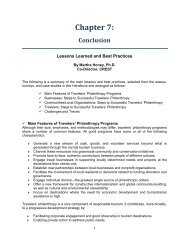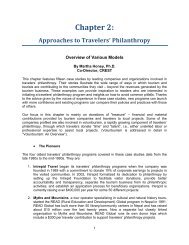Travelers' Philanthropy Handbook - Center for Responsible Travel
Travelers' Philanthropy Handbook - Center for Responsible Travel
Travelers' Philanthropy Handbook - Center for Responsible Travel
You also want an ePaper? Increase the reach of your titles
YUMPU automatically turns print PDFs into web optimized ePapers that Google loves.
your project and activities along the way, while you continue to learn and develop yourcapacities. When each small step is achieved there can be celebration, evaluation, andanalysis of what can be done better. Remember:• Decide what you and your project are, and what you are not. It is better to specializethan trying to be all things.• Prepare a mission statement and establish a clear set of objectives that define theboundaries.• Establish criteria <strong>for</strong> what you will support, <strong>for</strong> example:o Only not-<strong>for</strong>-profit or community based organizations or projectsooooArea of focus or causeWho will benefit? For example, the women in Village X; the people withdisabilities and their families in Community Y; the endangered wildlife in Zprovince; or the villagers living along the banks of the River G.Must the project be environmentally sustainable?Will the project become financially sustainable or self-sufficient, within a specificnumber of years? For example, an income generation project.• Step 6: Where Will the Money Come From?As a business owner, you already know the importance of establishing and managing a budget.Don’t overlook how critical it will be <strong>for</strong> your project to have one too. After you have set yourparameters and objectives in Step 5, carefully assess the cost of each step. Allow someadditional contingency funds, as there may be time over-runs, price increases, or over-lookedadditional expenses. Then give serious thought to how you can fund each one and maintain thesupport <strong>for</strong> the life of the project. Contributions can be generated from a number of sources:• From the company, <strong>for</strong> example, budgeted as a % of company profits, as an amount pertraveler, or as a fee built into the cost of the trip.• From travelers - at the time of booking, during, or after their trip.• From foundations and other grant making bodies.• From fund raising events, activities, and special appeals.Give consideration to administrative overheads and how they will be funded. If you are invitingyour travelers to contribute, you will have more success with your solicitations if 100% ofdonations will go to fund the project, with administrative costs being met by your travelcompany. If this is not feasible, you should ensure that no more than 10% of donated funds willbe used <strong>for</strong> administrative overheads. The public is generally wary of giving to any organizationthat needs their donations to cover much of the overhead expenses or fees. A very clear stancehere will help your ability to market your cause, and add to your credibility and transparency.• Step 7: Follow Sound Management Principles <strong>for</strong> Handling <strong>Travel</strong>ers’ <strong>Philanthropy</strong>FundsBy this point, you will probably have decided whether your company is simply going to makesome corporate donations to one or more local projects or organizations, or whether you wish tosolicit your travelers to give to the organization or the cause as well. <strong>Travel</strong>ers can give invarious ways:1) Directly to the local project or organization, or119















